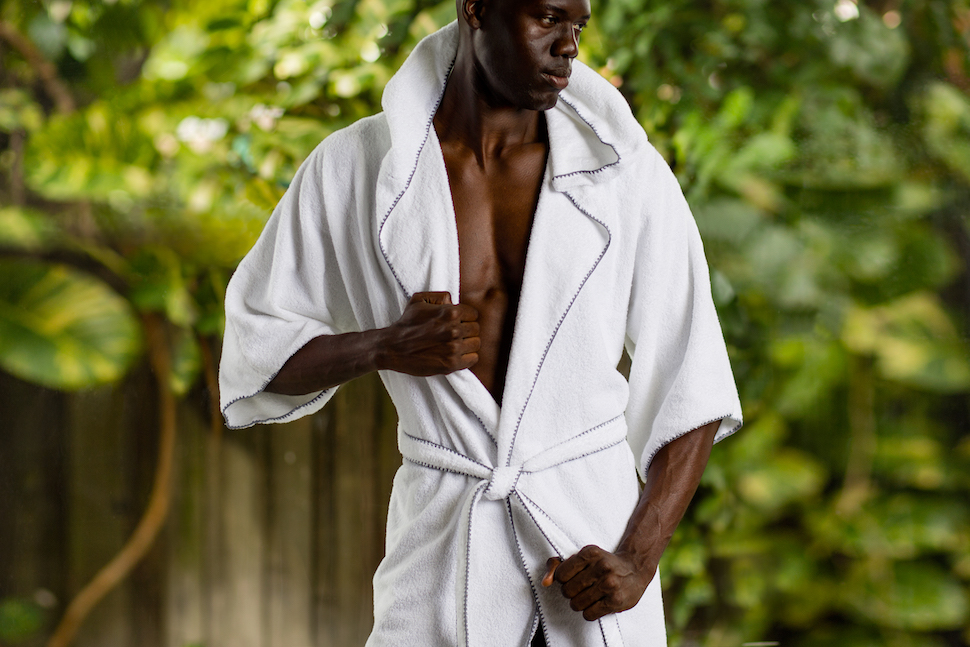
I write this from my boathouse in my robe as the sun comes up. In my decades of rowing on various crews I’ve seen countless sunrises from the water, and there is something truly glorious about being up before dawn and working really hard. Rowing as part of a crew can be magical, and the moment the sun and the blades hit the water is a moment the magic sinks in.
There is also a kind of magic in sitting in one’s special chair, writing on a laptop, and looking out through the glass doors of the boathouse as the sun hits the river. The boathouse is cool. The coffee is hot. What ties cool and hot and special chair and rising sun together is the perfect robe: at this moment, that’s a full-length, 100-percent combed cotton robe made by a company called The Madison Collection.
You may not think much about robes, and that’s your loss. Writers live much of their lives in robes, and know them like some folks know wines. Like wine, robes are seasonal and go with some things and not with others. The rich cultural history of robes is much too detailed to cover here, but keep in mind the classic tale of cannibals who mistakenly boiled a man wearing a brown robe with a rope sash. Alas, he was a friar.
Many robes are comfortable and functional enough but lack the gravitas to greet the FedEx guy, let alone the Mormon missionaries or Jehovah’s Witnesses who come knocking around here. The wrong robe suggests your soul is crying to be saved. The right robe, however, and the missionaries know they have no chance and won’t come back. You’re too comfortable in your own skin (or you forgot to tie the sash).
Glorious hotel or spa robes make great souvenirs or gifts because you’re bringing back a visceral feeling of a place you love.
Much worse are robes attempting too much—robes that loudly proclaim you have no clue who you are. A perfect robe should be experienced in the same way my parents described arriving at the world’s best restaurant in the South of France without a reservation. That was during the fifties, and they were made to feel as if the restaurant had been created and was waiting just for them. In the right robe, one should feel at complete ease coming out of the closet—whatever that means for you.
When I left Manhattan, my necktie collection was lost in transit and never replaced. My robe collection, however, keeps growing. Egyptian cotton, thick terry flannel, and even a surprisingly wonderful knit polyester robe from Glen Ivy Spa. Some robes are longer than others for that perfect mix of warm and cool. Inches matter. Whatever the length and material, a fine robe should get better with age and be as hard for a writer to give up as an old tweed jacket, even when the elbow patches wear through.
Glorious hotel or spa robes make great souvenirs or gifts because you’re bringing back a visceral feeling of a place you love. If you are very tall, however, a great hotel robe experience is rare. A long and light robe from the Four Seasons Resort Langkawi, Malaysia stands out as my favorite summer robe because it fits so well. One robe I regret not buying was from Auberge du Soleil in Napa: Moments after first entering our room came a knock on the door from a porter with a seasonally appropriate robe that fit perfectly. What made the experience so memorable is that the porter apologized as if he believed that not having the perfect robe already in the room had risked our entire experience. His other job was probably as a writer.
Stephen Kiesling
Stephen Kiesling is a writer and editor whose career was launched in 1982 with the classic rowing book The Shell Game and The New York Times Book Review, “Just as it is good that there was a riverboat pilot who could write…it is good that there is one true blue jock who can.” A Scholar of the House in philosophy at Yale, Stephen was a 1980 Olympic oarsman who also raced in the 2008 Olympic Trials. He learned journalism from T George Harris, a decorated World War II artillery scout and Time reporter who created Psychology Today. T George and Stephen launched both American Health magazine and Spirituality & Health, where Stephen continues as Editor at Large. He has written for the New Yorker, Sports Illustrated and Outside, was a spokesman for Nike, started a celebrated rowing club, and has built parks and playgrounds. He lives at Ti’lomikh Falls on the Rogue River in southern Oregon, where he writes for his wife Mary Bemis at Insidersguidetospas.com. Stephen is also the caretaker of one of America’s oldest Salmon Ceremonies and is working on a whitewater park and sculpture garden. He is interested in transformational retreats, anything to do with water, the Native American origins of our democracy, and the process of becoming what he calls an Earth-Indigenous Elder, a person who knows their own story from the beginning of time.